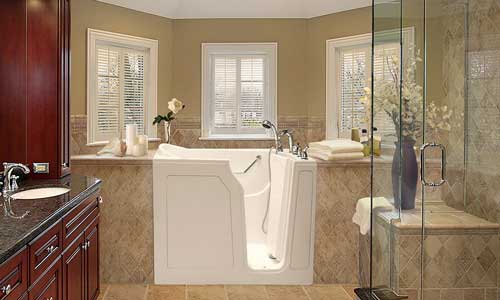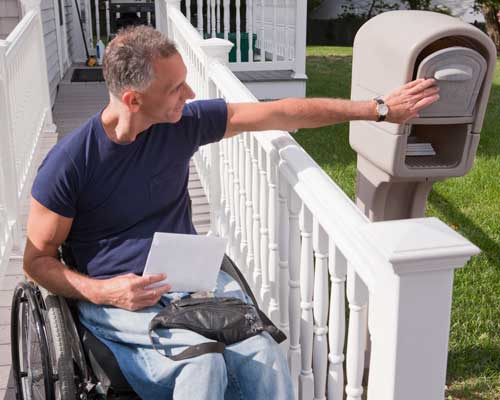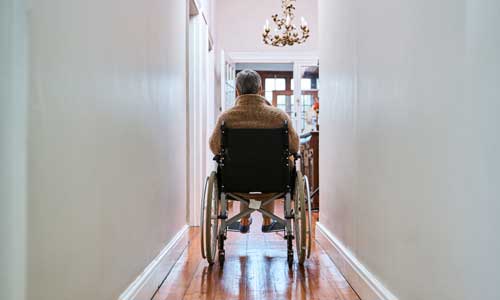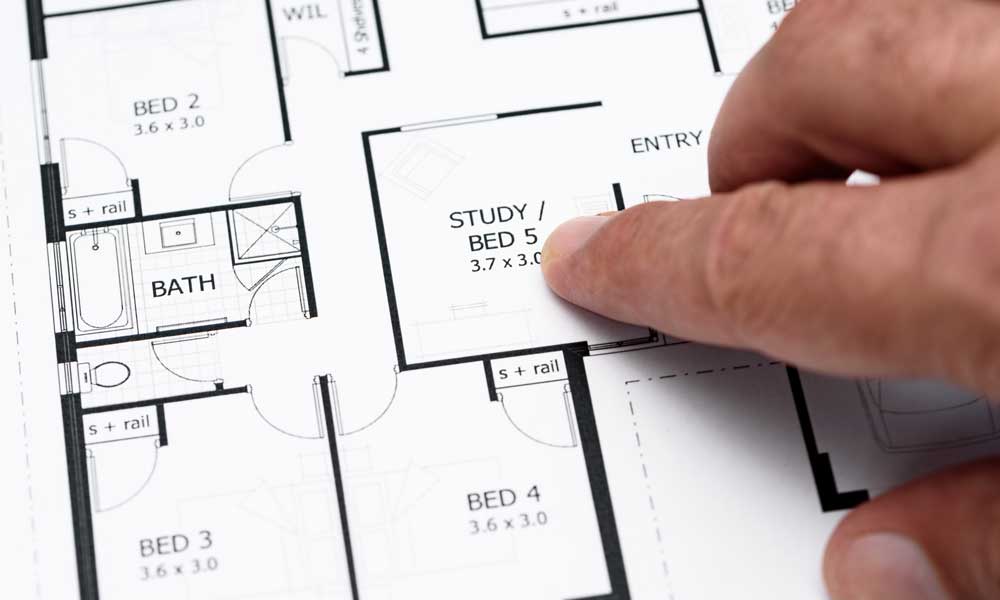As you age, deciding to stay in your home can be expensive but necessary. Despite the costs, the United States Aging Survey shows that many Americans aged 65 and older want to continue living in their homes as they grow older. To age in place successfully, it’s often necessary to remodel your home to make it safe for retirement.
How Will You Age?
Consider how you might change as you grow older before remodeling your house to accommodate life after retirement. Although medical advances are keeping seniors healthy and active longer, challenges are inevitable. Your eyesight and hearing may worsen, and stairs might become difficult to navigate. The soaker tub you once enjoyed may become a hazardous ledge to climb, and doorways might require widening to accommodate a wheelchair or walker.
Healthcare experts worry most about falling and tripping as we grow older and less steady on our feet. The U.S. Centers for Disease Control and Prevention pinpoints some conditions that make falling more likely, including lower body weakness, throw rugs or clutter, vitamin D deficiencies, and some medicines like tranquilizers, sedatives or antidepressants. Even some over-the-counter medications can affect your balance
Aging in Place Costs Less than the Alternative
The good news is that price tag on most remodeling projects is under $10,000, which is far less than what you might spend on a nursing home. The average cost for a semi-private room in a nursing home is $7,900 per month, while a private room costs more than $9,000 per month. A one-bedroom unit in an assisted living facility runs about $4,500 per month.
What Remodeling Do You Need to Age in Place?
Determining how you need to accident-proof your home is necessary before beginning the remodeling process. Evaluate how you will live in and use your house while reflecting on the challenges you expect in your later years to discover which areas pose the most potential for danger. It’s important to think about different ways to use the space in your home as you age. For example, you might not need as big of a house as you think.
If you need help with identifying medically-required home modifications for your safety, Medicare Part B will likely foot the cost of an occupational therapist who can evaluate your home and determine what alterations are necessary. If you have Medicare Part C coverage, this supplemental insurance may pay for the cost of renovations.
Also, the National Association of Home Builders certifies aging-in-place specialists trained in strategies and techniques for designing and building aesthetically pleasing, barrier-free living environments. The cost of an evaluation is usually paid by the hour or a flat fee per visit or project. Prices vary according to the contractor’s background and the demands of the project. The NAHB offers a certified aging-in-place specialist directory.
We’ve also put together an aging in place remodeling checklist to help make sure you’ve covered all the areas of your home.
| Project | Price Range to Install* | Avg. Cost to Install* |
|---|---|---|
| Walk-in Tub or Shower | $3,000 to $15,000 | $5,000 |
| Ramp Installation at Entrance | $875 to $1,750 | $1,110 |
| Widen an Entry Door | $200 to $7,000 | $800 |
| Stair lift Installation | $3,000 to $20,000 | $8,000 |
| Install Entry Handrails | $700 to $1,200 | $900 |
| Install an Elevator | $33,000 to $60,000 | $45,000 |
| Install Lever Taps on Faucets | $150 to $330 | $220 |
| Widen Hallways w/out Structural Changes | $800 to $1,400 | $1,100 |
| Widen Hallways with Structural Changes | $30,000 to $40,000 | $35,000 |
| Replace 10 Windows | $5,500 to $10,500 | $8,000 |
| Remodel Bathroom | $6,600 to $28,000 | $11,200 |
| Kitchen Countertop Height Adjustment | $15,000 to $20,000 | $18,000 |
*Prices vary by location
Remodeling Costs as You Age
Deciding what remodeling to do depends on your needs. Some rooms may require extensive renovations, while others will need minor adjustments. Here’s a look at some common remodeling projects:
- Install Non-slip Flooring
Falls are a leading cause of death and injury for older Americans. Many of those injuries—about one-third—take place in the bathroom. One way to reduce slipping or falling on a wet bathroom floor is to replace the floor with a nonslip surface. The cost to have a professional tackle this project runs from $6,400 to $11,000, depending on labor rates in your area.
 Source: Bath Creations
Source: Bath CreationsIf you choose to do this project yourself, a variety of materials such as rubber flooring, slip-resistant vinyl, or cork offer traction or cushioning and cost less than $3 per square foot. Non-slip rugs and bath mats are another option and generally cost about $10 to $15 for a small one. A non-slip spray is between $20 and $30, and water-resistance adhesives go for about $40 to $50.
- Walk-in Tub or Shower Installations
Making a bathroom safer may require a walk-in tub or showerwith lower entry points to remove trip hazards. Installing a walk-in tub varies from $3,000 to $15,000. The average price of a walk-in whirlpool tub, including installation, is between $5,000 and $7,000. The national average cost of putting in a walk-in shower is $3,300.
- Wider Doorways for Wheelchairs
The Americans with Disabilities Act (ADA) requires doorways of at least 32 inches wide to accommodate wheelchairs or walkers. Costs for widening doorways vary drastically depending on the type of door replacement and hardware, and whether the contractor needs to move electrical wiring or plumbing. Doors that unlock with a key fob cost several thousand dollars but can pay off due to the increased mobility offered to someone in a wheelchair. You will pay $200 to $7,000 for a wider entry door.
- Installing a Ramp
 Source: Getty
Source: GettyPermanent ramps make entering and exiting with a walker or wheelchair more manageable. If installed by a professional, you’ll need to budget between $875 and $1,750, or $100 to $250 per square foot. The price will vary according to the type of materials used and local labor costs. The standard ramp size is 30 feet long, 30 inches wide, and 30 inches high. A portable ramp without installation can cost as little as $60 and as high as $800, though they aren’t as aesthetically pleasing.
- Install Stair Lifts or Handrails
Someone who can no longer climb stairs may need a stair lift to access the upper levels of a house. The price ranges from $3,000 to $20,000. Installing handrails in a stairway is about $100 per foot, or $700 to $1,200 on average, depending on your stairway. If your stairs can’t accommodate a chair lift, installing an elevator costs about $33,000 to $60,000.
- Change Faucets to Levers
Pain in your hands can make even the smallest tasks a challenge. Changing out faucets to ones with a lever handle can make them easier to use. This project usually costs $90 to $550, with most installations ranging from $150 to $330.
- Wider Hallways for Wheelchairs
 Source: Getty
Source: GettyYou’ll spend between $800 and $1,400 to widen hallways to accommodate wheelchairs. However, the price can increase significantly if electrical work is required to address outlets or carpentry work is required to rebuild cabinets and change doors. If walls are structural, your costs will jump from $30,000 to $40,000. The ADA states the minimum hallway width should be 32, though some wheelchairs are 36 inches wide.
- Replace Windows for Ease of Use
Old windows are less energy efficient than modern models. Installing a new, standard 36-by-60 double-hung replacement window is generally between $550 to $1,050 for each window. Size, type of materials and other factors contribute to the cost.
- Bathroom Remodeling
Remodeling a bathroom may be the most important project to consider as you age. The costs range from $6,600 to $28,000. The final price will be determined by the room size, whether you need to change out fixtures, or redo plumbing and electrical. Big ticket items for a bathroom remodel are walk-in tubs and showers.
- Lower the Kitchen Countertops
Seniors who have trouble bending may want to install higher countertops or a more shallow sink. On the other hand, those who are in wheelchairs may need to have cabinets and counters lowered. The cost of making your kitchen more accessible is in the $15,000 to $20,000 range. This includes having a contractor lower your countertops.



